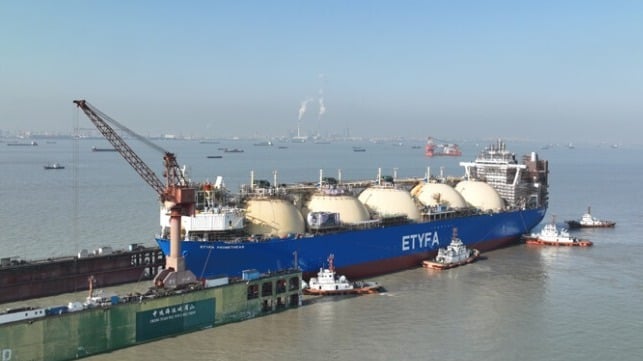First FSRU for Cyprus Begins Commissioning at Cosco Shipyard

The commissioning phase of the first FSRU being converted in Shanghai for Cyprus has begun. The vessel completed its second dry docking on March 4 at the Cosco Shipping Heavy Industry yard and is now preparing for trials before departing for the Mediterranean this year. The project, which has been delayed by several complications, calls for the FSRU to operate in Cyprus till 2044.
The project which is expected to cost approximately €315 million when it is completed is being called the biggest ever project in the history of Cyprus and will create the island’s first LNG facility. The 72,780 dwt LNG carrier built in 2002 as the Gria will be permanently docked less than a mile off the coast of Limassol, Cyprus in Vasilikos Bay. The project plans to directly connect the vessel to the Vasilikos power station.
The European Bank for Reconstruction and Development, which provided $95 million of funding to acquire the vessel for conversion, calls this project critical to Cyprus’ energy security and will help to meet the island’s environmental goals. The FSRU will replace heavy fuel oil used at the power plant. It is estimated that 90 percent of the island’s power supply comes from heavy fuel.
In addition to the bank financing, The European Union provided an additional $120 million of funding for the project. The European Investment Bank also provided a loan and the Electricity Authority of Cyprus is also participating in the project.
Cosco reports that the vessel arrived at its shipyard in August 2022 to begin the FSRU modification program. Work on fabricating the regasification module had begun in October 2021 and a separate power module in December 2021. In addition to the capability to handle LNG coming from large tankers with a capacity between 120,000 and 217,000 cbm, the conversion is installing a dual power system that will permit the vessel to be powered from the LNG onboard. It also has a backup capability to switch to diesel power in an emergency. The FSRU will have a storage capacity of 1225,000 cbm.
The second phase of the dry dock operation began on February 17. They were installing a ballast pipe, outboard pipe in the engine room, renewal of bottom plate, and other projects including sandblasting and painting the vessel. Cosco reports it was able to complete 20.000 square meters of sandblasting in just 56 hours before inclement weather that would have interrupted the operation. They completed painting the vessel and installing the propeller as well as inspections in a 20-day operation. They had previously completed lifting and installing the regasification unit and compressor.
The vessel was renamed Etyfa Prometheas during the dry dock and she will be re-registered in Cyprus. Reports from Cyprus said the vessel is expected to arrive by this summer with the project approximately nine months behind the latest timetable due to supply chain delays created by the pandemic.

that matters most
Get the latest maritime news delivered to your inbox daily.
Work began in January on the jetty where the FSRU will be moored along with the pipeline that will connect it to the power plant. This portion of the project is scheduled to be completed by July.
The project is the latest example of the strong demand for FSRU units and the conversions currently underway to build LNG infrastructure. Last week, it was reported that work has begun in Singapore for a similar vessel conversion that will provide Greece’s first FSRU and LNG import operation in the eastern portion of the country. Work is also planned to complete the additional FSRUs chartered by Germany and due to be introduced in the coming months. The German government committed to a total of five FSRUs in the first phase of building the country’s import infrastructure and exploration is already underway to increase the capacity at the government-led projects in Western Germany as well as a private project developed by Deutsche Gas in eastern Germany.
